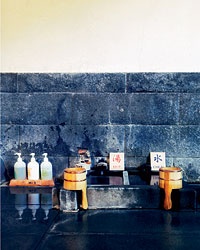 Pia Ulin The shower area at the bathhouse.
From warp speed to time warp: a mother and daughter cap off a Tokyo spree with a night at a Japanese spa.
Pia Ulin The shower area at the bathhouse.
From warp speed to time warp: a mother and daughter cap off a Tokyo spree with a night at a Japanese spa.
We had just spent a week tackling Tokyo. My 14-year-old daughter, Moa, a manga fan who studies Japanese after school, led the way. We ate mochi ice cream; shopped Shibuya 109, a 10-story dream mall for teens (where I discovered that customers and clerks exchange credit cards with two hands in Japan); devoted an afternoon to watching Spirited Away and admiring the giant robot sculpture at the Ghibli Museum; and had tea with a view of the entire city at the Park Hyatt, the Lost in Translation hotel. By the time we hopped on the bullet train, we were ready to switch gears. The Shinkansen zipped us to Mishima, where we caught a smaller train that purred through beautiful country with Mount Fuji as a backdrop. It was like traveling through a painted scroll. An hour later we were in the Katsura River town of Shuzenji, home to the Arai Ryokan, a 136-year-old onsen, or spa, built around a hot spring.
Related: Nine Great Meditation Retreats
Some onsen are exclusive and insanely expensive; others basic. This one—a clutch of wooden buildings that look Modernist in their simplicity—falls in the middle. We were given a fantastic room with a balcony directly above the river. Donning yukata (cotton robes) and slippers, we headed for a soak in the springs, which are set in a Zen garden with a carp pond. It was late October, and the maples had turned a stunning red. We started to, too (it was hot!), but we felt wonderful. Back in our quarters, we sat on cushions at a low table while a woman in a kimono showed us a lengthy dinner menu. We expected to have to choose—then realized it was all coming our way, each course a miniature ceremony. Some dishes were delicious (tuna sashimi arranged like a flower); others so strange and unidentifiable (a doughy ball with a chalky flavor) that Moa resorted to hiding them in our bathroom, so as not to upset the kimono lady. After the meal, she unfurled futons and the fluffiest duvets. We fell asleep to the sounds of the river.
At the bathhouse the next morning we learned that before getting into the tubs, you have to wash up in the traditional way: you sit on a stool, douse yourself with hot and cold spring water from wooden buckets, and scrub with a rough towel. Then you enter a room with big windows and light beaming in on an array of pools. We wished we had more than a night at the Arai, but when we checked out, we were two very clean, serene girls.